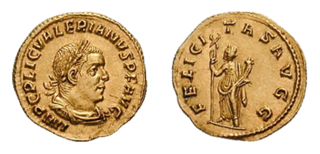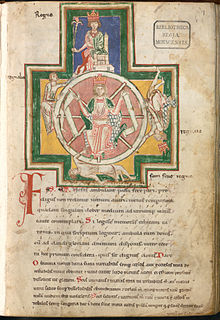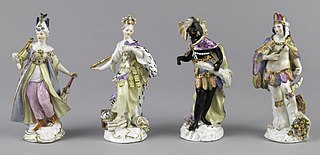
Venus is a Roman goddess, whose functions encompassed love, beauty, desire, sex, fertility, prosperity and victory. In Roman mythology, she was the ancestor of the Roman people through her son, Aeneas, who survived the fall of Troy and fled to Italy. Julius Caesar claimed her as his ancestor. Venus was central to many religious festivals, and was revered in Roman religion under numerous cult titles.

In ancient Roman religion and myth, Faunus[fau̯nʊs] was the horned god of the forest, plains and fields; when he made cattle fertile he was called Inuus. He came to be equated in literature with the Greek god Pan.

In ancient Roman religion, Ceres was a goddess of agriculture, grain crops, fertility and motherly relationships. She was originally the central deity in Rome's so-called plebeian or Aventine Triad, then was paired with her daughter Proserpina in what Romans described as "the Greek rites of Ceres". Her seven-day April festival of Cerealia included the popular Ludi Ceriales. She was also honoured in the May lustratio of the fields at the Ambarvalia festival, at harvest-time, and during Roman marriages and funeral rites.

In ancient Roman culture, felicitas is a condition of divinely inspired productivity, blessedness, or happiness. Felicitas could encompass both a woman's fertility, and a general's luck or good fortune. The divine personification of Felicitas was cultivated as a goddess. Although felicitas may be translated as "good luck," and the goddess Felicitas shares some characteristics and attributes with Fortuna, the two were distinguished in Roman religion. Fortuna was unpredictable and her effects could be negative, as the existence of an altar to Mala Fortuna acknowledges. Felicitas, however, always had a positive significance. She appears with several epithets that focus on aspects of her divine power.

Pietas, translated variously as "duty", "religiosity" or "religious behavior", "loyalty", "devotion", or "filial piety", was one of the chief virtues among the ancient Romans. It was the distinguishing virtue of the founding hero Aeneas, who is often given the adjectival epithet pius ("religious") throughout Virgil's epic Aeneid. The sacred nature of pietas was embodied by the divine personification Pietas, a goddess often pictured on Roman coins. The Greek equivalent is eusebeia (εὐσέβεια).

Fortuna was the goddess of fortune and the personification of luck in Roman religion who, largely thanks to the Late Antique author Boethius, remained popular through the Middle Ages until at least the Renaissance.

Maia, in ancient Greek religion, is one of the Pleiades and the mother of Hermes.
In ancient Roman religion, Mana Genita or Geneta Mana is an obscure goddess mentioned only by Pliny and Plutarch. Both tell that her rites were carried out by the sacrifice of a puppy or a bitch. Plutarch alone has left some examination of the nature of the goddess, deriving Mana from the Latin verb manare, "to flow", an etymology which the Roman grammarian Verrius Flaccus also relates to the goddess Mania mentioned by Varro, and to the Manes, the souls of the departed. In a Greek equivalence perspective, Plutarch, on account of the bitch sacrifice, loosely connects the goddess to Hekate and in parallel notes that Argive sacrificial practice makes as well for an interesting comparison for her with Eilioneia, meaning the birth goddess Eileithyia. Some modern commentators have elaborated on the "Genita" and "Mana" qualifiers, to suggest she were a goddess who could determine whether infants were born alive or dead. Others have suggested that Horace may be referring to this goddess when he mentions a goddess Genitalis in the Carmen Saeculare. Some have compared it to the Oscan Deiua Geneta, while still others deem that Genita Mana may be only a vague epithet like Bona Dea rather than an actual theonym.

Roman art refers to the visual arts made in Ancient Rome and in the territories of the Roman Empire. Roman art includes architecture, painting, sculpture and mosaic work. Luxury objects in metal-work, gem engraving, ivory carvings, and glass are sometimes considered in modern terms to be minor forms of Roman art, although this would not necessarily have been the case for contemporaries. Sculpture was perhaps considered as the highest form of art by Romans, but figure painting was also very highly regarded. The two forms have had very contrasting rates of survival, with a very large body of sculpture surviving from about the 1st century BC onward, though very little from before, but very little painting at all remains, and probably nothing that a contemporary would have considered to be of the highest quality.

Interpretatio graeca or "interpretation by means of Greek [models]" is a discourse used to interpret or attempt to understand the mythology and religion of other cultures; a comparative methodology using ancient Greek religious concepts and practices, deities, and myths, equivalencies, and shared characteristics.

In ancient Roman religion and magic, the fascinus or fascinum was the embodiment of the divine phallus. The word can refer to the deity himself (Fascinus), to phallus effigies and amulets, and to the spells used to invoke his divine protection. Pliny calls it a medicus invidiae, a "doctor" or remedy for envy or the evil eye.

An engraved gem, frequently referred to as an intaglio, is a small and usually semi-precious gemstone that has been carved, in the Western tradition normally with images or inscriptions only on one face. The engraving of gemstones was a major luxury art form in the Ancient world, and an important one in some later periods.

The Thetford Hoard is a hoard of Romano-British metalwork found by Arthur and Greta Brooks at Gallows Hill, near Thetford in Norfolk, England, in November 1979, and now in the British Museum. Dating from the mid- to late-4th century AD, this hoard is a collection of thirty-three silver spoons and three silver strainers, twenty-two gold finger rings, four gold bracelets, four necklace pendants, five gold chain necklaces and two pairs of necklace-clasps, a gold amulet designed as a pendant, an unmounted engraved gem, four beads, and a gold belt-buckle decorated with a dancing satyr. A small cylindrical lidded box made from shale also belonged to the hoard.

In ancient Roman religion, Vagitanus or Vaticanus was one of a number of childbirth deities who influenced or guided some aspect of parturition, in this instance the newborn's crying. The name is related to the Latin noun vagitus, "crying, squalling, wailing," particularly by a baby or an animal, and the verb vagio, vagire. Vagitanus has thus been described as the god "who presided over the beginning of human speech," but a distinction should be made between the first cry and the first instance of articulate speech, in regard to which Fabulinus was the deity to invoke. Vagitanus has been connected to a remark by Pliny that only a human being is thrown naked onto the naked earth on his day of birth for immediate wails (vagitus) and weeping.

Roman mythology is the body of traditional stories pertaining to ancient Rome's legendary origins and religious system, as represented in the literature and visual arts of the Romans. "Roman mythology" may also refer to the modern study of these representations, and to the subject matter as represented in the literature and art of other cultures in any period.

The Snettisham Jeweller's Hoard is a collection of Romano-British jewellery and raw materials, found during the construction of a house in the Norfolk village of Snettisham in 1985. The hoard is thought to be the working stock of a jeweller, buried in a single clay pot around 155 AD. The finds include the working tip of a quartz burnishing tool, partially or fully completed items of jewellery, and raw materials: mainly silver coins, scrap silver items and silver ingots, but also six pieces of scrap gold, and many engraved gemstones to be set in rings. The presence of scrap gold and silver and absence of base metals indicates that the jeweller dealt mainly with high-status customers.

Fortuna Huiusce Diei was an aspect of the goddess Fortuna, known primarily for her temple in the Area Sacra di Largo Argentina at Rome. Cicero lists her among the deities who should be cultivated in his ideal state, because "she empowers each day". She thus embodies an important aspect of time as it figures in Roman religion: every day of the year had a distinct and potent nature, which the public priests were responsible for knowing and aligning the community with by means of the religious calendar.





























